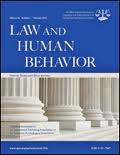 Female veterans were almost 3 times more likely to engage in family violence whereas male veterans were more than 3 times more likely to aggress against strangers. This is the bottom line of a recently published article in Law and Human Behavior. Below is a summary of the research and findings as well as a translation of this research into practice.
Female veterans were almost 3 times more likely to engage in family violence whereas male veterans were more than 3 times more likely to aggress against strangers. This is the bottom line of a recently published article in Law and Human Behavior. Below is a summary of the research and findings as well as a translation of this research into practice.
Featured Article | Law and Human Behavior | 2014, Vol. 38, No. 1, 1-9
PTSD Symptoms and Family Versus Stranger Violence in Iraq and Afghanistan Veterans
Author
Abstract
As a diagnosis, posttraumatic stress disorder (PTSD) has been associated with violence committed by veterans in many studies; however, a potential link to specific PTSD symptoms has received relatively less attention. This paper examines the relationship between PTSD symptoms and different types of violent behavior in Iraq and Afghanistan veterans. Participants were randomly sampled from a roster of all separated U.S. military service members or national guard/reservists who served after September 11, 2001. Data were collected at baseline and 1-year follow-up from a national sample of N = 1,090 veterans, from 50 states and all military branches. Of these veterans, 13% reported aggression toward a family member and 9% toward a stranger during the 1-year study period. Anger symptoms at baseline predicted higher odds of family violence at follow-up, both severe (OR = 1.30, CI [1.13, 1.48], p < .0001) and any (OR = 1.28, CI [1.19, 1.37], p < .0001). PTSD flashback symptoms at baseline predicted higher odds of stranger violence at follow-up, both severe (OR = 1.26, CI [1.11, 1.42], p < .0001) and any (OR = 1.16, CI [1.05, 1.28], p < .0029). Analyses revealed that males were more likely to engage in stranger violence, whereas females were more likely to endorse aggression in the family context. The results provide limited support to the hypothesis that PTSD “flashbacks” in veterans are linked to violence. The differing multivariate models illustrate distinct veteran characteristics associated with specific types of violence.
Keywords
PTSD, veteran, violence, symptomology
Summary of the Research
Researchers sent requests to complete a 35-minute online survey to 3000 randomly selected US Veterans who had served on or after September 11, 2011 and who were separated from the military. 1,388 participants completed the baseline survey (a 56% response rate) and 1,090 of those also completed a follow-up survey 1 year later (79% retention rate).
Respondents were asked to complete a series of questions addressing a number robust risk factors for violence in veterans populations including substance misuse, combat exposure, and probable PTSD (asking about such symptoms as flashbacks, emotional numbing, anger, hypervigilance, and physical reaction to reminder).
One year later, participants were again surveyed and asked to report on measures of various types of violence, towards both family and strangers, within the last year.
The median age of respondents was 34.4 years, “the majority (82%) of the sample had been deployed to Iraq or Afghanistan; time since last deployment ranged from 1 to 8 years with a median of 4 years. The remainder of the sample was composed of veterans who served in Operation Iraqi Freedom or Operation Enduring Freedom but were not stationed in the theater of combat…The final sample was geographically representative of the military, corresponded to known military demographics, and represented 50 states, Washington DC, and four territories in approximately the same proportion as the actual military” (p. 3).
About half of the sample (49%) experienced high levels of combat and almost one-fifth (18%) were diagnosed with PTSD.
About half of the sample (49%) experienced high levels of combat and almost one-fifth (18%) were diagnosed with PTSD.
Results also showed: (p. 4)
- All of the PTSD symptoms were significant at the p < .0001 level with all types of violence
- Younger age and high combat were also positively related to all types of violence
- Witnessing family violence was positively related to family aggression and severe family violence
- History of arrest was positively related to stranger aggression and severe stranger violence
- Females were more likely to perpetrate family aggression and severe family violence
- Men were more likely to commit aggression or severe violence towards strangers
- Drug misuse was not related to family aggression, but was positively related to all other types of violence
- The strongest effect was found for both anger and being on guard with respect to family aggression
- The weakest effect for PTSD variables was becoming physically upset from a reminder
In addition, logistic regression analyses indicate: (pp. 4-5)
- Older veterans had significantly lower odds of family aggression, severe family aggression, and stranger aggression compared to younger veterans
- Females were almost 3 times as likely to commit severe family violence compared to males
- Males were more than 3 times as likely to commit stranger aggression than females
- Substance use increased the odds of stranger aggression by about 2.5 times
- Veterans with high-combat exposure were about 2.5 times more likely to commit stranger aggression
- Veterans with high-combat exposure were about 4 times more likely to engage in severe family aggression
Translating Research into Practice
There are several clinical implications of this research. “First, if a clinician wanted to identify risk factors of general interpersonal violence in veterans, evaluating the exposure to combat, substance use disorders, or intensity of PTSD flashback symptoms would be among the relevant information to consider…These factors may also affect one another, as people experiencing flashbacks may use substances to alleviate and “self-medicate” symptoms, which in turn may also cause these symptoms to intensify” (p. 7).
“Second, if a clinician were to identify risk factors for family violence, intensity of anger symptoms may be very useful information if a veteran has indicated they have PTSD. Veterans with PTSD have been shown to endorse hyperarousal symptoms more than any other clusters…clinicians can use this data to focus their efforts on the most relevant factors in hope of preventing violence” (p. 7).
Legal Practitioners
These results provide data indicating, “PTSD symptoms appear to contribute to increased odds of specific types of violence in veterans…[thus] it would be worthwhile for attorneys to examine what type of violence a defendant engaged in and how the individual’s PTSD may have affected their behavior. With respect to specialty veterans courts, even if a defendant is arrested for a nonviolent crime, early screening may be beneficial in providing the opportunity to prevent violent behavior by connecting veterans with early treatment” (p. 7).
Other Interesting Tidbits for Researchers and Clinicians
This study had one of the highest response rates in recent national surveys of US troops; their retention rate 1 year later was also very high. Over 50% of survey recipients completed the survey and, of those, almost 80% completed the follow-up survey 1 year later. Researchers thinking of using survey methodology might consider have a look at the procedures used in this study, and the Dillman method of sampling, referenced in this article (see p. 3).
Researchers oversampled for female respondents and then used a weighting procedure to adjust sample proportions to represent an accurate reflection of true proportions.
Join the Discussion
As always, please join the discussion below if you have thoughts or comments to add!
















